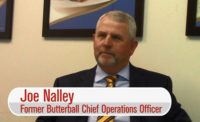Joe Nalley Interview Part 2: What drives efforts toward efficiency
Former Butterball COO Joe Nalley spoke with The National Provisioner editor-in-chief Andy Hanacek as he retires after 46 years about a variety of topics in the industry. Watch all videos here. In the second part of the series, Nalley discusses how companies have used vertical integration to become more efficient and what drives efforts toward efficiency.
Andy Hanacek: Thanks Joe for joining me for another Q&A here on a topic as you retire after 46 years in the industry. Congratulations on that. Let’s talk about efficiency and looking at it from an industry wide segment, not necessarily a process efficiency specifically. Almost live supply side, supply chain efficiency. Some of those areas the industry has gotten really good in 46 years. In your opinion, what have you seen?
Joe Nalley: I think one of the real keys is that the different segments of the industry, whether it is genetics or the feed companies or the live producer or the processor and ultimately onto the customer, we all talk to each other more now than we ever have, and in some areas such as turkey or chicken and to some degree hogs, cattle maybe a little less so, there’s something being employed called a fully integrated model where when you make decisions about what genetics you are going to use, how you are going to feed the animal, even what sort of housing might work the best or what conditions, what products is that animal going to end up going into, how you package it, all the way to the consumer, all of that is looked at as a big picture instead of the individual segments. When I first started in the industry, the farmer was kind of doing his thing and making it what worked the best for him and what was the most efficient and economic. Processors were doing somewhat the same, and nobody was really looking at the whole picture, so when you take it all into consideration, it really gives you a different mindset about what’s possible, what makes sense, where can you really drive the efficiencies, and it’s been interesting to see that.
Hanacek: I assume that has also helped in terms of the product mix and product quality over the course of time too. If you have ranchers and farmers raising the animals a certain way to get an end result at the consumer level, that’s got to be beneficial not just from an efficiency standpoint but also the quality.
Nalley: No question, and we have a more discerning consumer today than we’ve ever had. Consumers are more demanding as they well should be. So if somebody wants grass-fed beef as opposed to cattle out of the feed lot, then that process has to start back at the genetics and go all the way through to the packaging and ultimately maybe even to a particular stores or segments in the stores that are catered to them whether it be organic or grass-fed or antibiotic-free or whatever it is. It’s really driven by what the consumer is looking for these days.
Hanacek: That was going to be my next question. What has been the catalyst over these 46 years to drive the industry into that vertical integration, that vertical supply chain. Has it been consumer drive straight-out, or are there other things that have pushed it?
Nalley: It has been consumer driven, but it is also just driven by economics. At the end of the day, folks are in this to be profitable and make money, and you have to find the best, most efficient way to do things. Doing things in the different segments might be beneficial here but not for the overall supply chain. So I’d say economics have driven it at least as much as the consumer. At the end of the day, cost may not be king because there are other attributes you are willing to pay for, but you still have to do this at a competitive cost.
Check out the rest of our video series with former Butterball COO Joe Nalley!
Looking for a reprint of this article?
From high-res PDFs to custom plaques, order your copy today!





